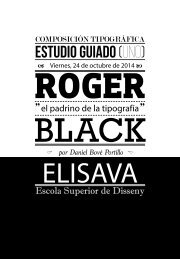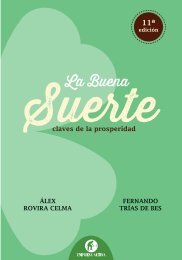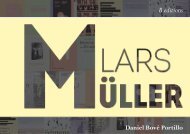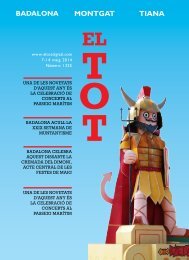Muller
Create successful ePaper yourself
Turn your PDF publications into a flip-book with our unique Google optimized e-Paper software.
B editions<br />
Daniel Bové Portillo
Daniel Bové Portillo<br />
LARS<br />
MÜLLER<br />
B editions
3<br />
index
I) introduction<br />
II) who?<br />
III) when?<br />
IV) where?<br />
V) what?<br />
VI) conclusion<br />
VII) reference<br />
5/6<br />
7/10<br />
11/12<br />
13/14<br />
15/30<br />
31/32<br />
33/34<br />
4
5<br />
introduction<br />
I<br />
This book might be a special one,<br />
you will get to know one of the smartest publisher and graphic<br />
designers of our current generation.<br />
He influenced the industry in so many ways and changed the way of<br />
thinking and isnpired lots of nowadays publishers.<br />
Do you want to know more about him ? So keep reading
The digital hype is over. New media and<br />
digital tools are integrated into our<br />
work and lives. Are we still excited? Do<br />
we feel something is missing? Perhaps<br />
the experience of reality? By means of real-time<br />
processes and physical objects (like buildings<br />
and books)the lecture explores sensations<br />
of the ordinary and qualities of the familiar<br />
to promote a spectacular third way into the<br />
medial future: digital and analog.<br />
Lars Müller is a graphic designer and publisher<br />
based in Switzerland. He established his<br />
design studio in 1982 and started publishing<br />
books on typography, design, art, photography,<br />
and architecture.<br />
Lars Müller Publishers have published over<br />
600 titles to date, many winning awards for<br />
their content and design. Müller has taught at<br />
various universities in Switzerland and Europe<br />
and is currently a guest lecturer at the Harvard<br />
University Graduate School of Design.<br />
6
7<br />
who?<br />
II<br />
Be prepared to know one of the mos important and influencing<br />
book designers of all times, his work<br />
is magnificient as he knows everything about books.<br />
For him a book is not just an object that you read, is more<br />
than that. It is an amazing<br />
experience that involves all senses.
Lars Müller was born in Oslo in 1955, and<br />
although a Norwegian citizen, has been<br />
based in Switzerland since 1963.<br />
After an apprenticeship as a graphic designer<br />
and some years as a peripatetic student<br />
in the United States and Holland, Lars<br />
Müller returned to Switzerland in 1982 and<br />
established his studio in Baden. Since 1996, he<br />
has been a partner of “Integral Concept,” an<br />
interdisciplinary design group active in Paris,<br />
Milan, Zürich, Berlin, and Montreal.<br />
Lars Müller started publishing books on<br />
typography, design, art, photography, and<br />
architecture in 1983 and, as Lars Müller<br />
Publishers, has produced some 300 titles<br />
to date. Recently, he has branched out into<br />
visually oriented books on social issues, such as<br />
human rights and ecology.<br />
He is a passionate educator and has taught<br />
at various universities in Switzerland and<br />
elsewhere in Europe. Since 2009 he has<br />
been a guest lecturer at Harvard's Graduate<br />
School of Design. Lars Müller is currently<br />
the international president of AGI Alliance<br />
Graphique Internationale and a member of<br />
MOTOVUN International Publisher's Group.<br />
8
9<br />
II) who?
Lars Müller is a graphic designer and publisher<br />
based in Switzerland. He established his design<br />
studio in 1982 and started publishing books<br />
on typography, design, art, photography, and<br />
architecture.<br />
Lars Müller Publishers have published over<br />
600 titles to date, many winning awards for<br />
their content and design. Müller has taught at<br />
various universities in Switzerland and Europe<br />
and is currently a guest lecturer at the Harvard<br />
University Graduate School of Design.<br />
As well as being a publisher, Lars Müller<br />
is also a designer outside the sphere of books.<br />
Corporate Design, Corporate Publishing<br />
and Signage Systems are the focal points for<br />
“Integral Lars Müller,” the design studio, which<br />
currently employs four designers.<br />
Lars Müller offers his conceptual advice<br />
in communication and design to institutions<br />
and enterprises according to his personal<br />
interests. He frequently serves on academic and<br />
competition juries.<br />
Since 1996 the studio has been a partner of<br />
Integral Concept, a group of five studios with<br />
the same intellectual approach but different<br />
key interests from architecture to product<br />
design, and located in Paris, Milan, Zürich,<br />
Berlin, and Montreal.<br />
Lars Müller Publishers is an internationally<br />
active publishing house based in Zurich,<br />
Switzerland. It came into being in 1983, as a<br />
result of the bibliophile passion of designer Lars<br />
Müller. The press has made a worldwide name<br />
for itself – and not just in specialist fields – with<br />
carefully edited and designed publications<br />
on architecture, design, photography,<br />
contemporary art and society.<br />
Lars Müller works closely with his<br />
authors to produce significant publications of<br />
great independence, to the highest possible<br />
standards.<br />
Lars Müller Publishers presents its program<br />
as a “school of seeing.” It offers a precise<br />
selection from the unmanageable flood of<br />
visual events, and brings together authors,<br />
designers, and artists who stand for quality and<br />
tenacity in their own right.<br />
Lars Müller Publishers is a member of SWIPS<br />
(Swiss Independent Publishers).<br />
10
11<br />
when?<br />
III<br />
To know more about the author we have to thimk about<br />
the era that he lived to understand more his innovative<br />
mind and his way of thinking that has been always<br />
really advaced . If we get to know more about the years<br />
that the editor has been working on the employment
The stage that covers the working<br />
period of Lars Müller will be since he<br />
established Lars Müller Publishers<br />
in the 80s to the actuallity when<br />
he is still currently working with the same<br />
company, so we are talking about that he has<br />
been working for his same enterprise for more<br />
than 30 years.<br />
On the last years there has been a huge<br />
change of methods o making books, from the<br />
way of thinking how to do the book to the<br />
printing. And he has always adapted to the new<br />
methods really quickly in order to learn the<br />
best methodes to make our experience to read<br />
books better.<br />
12
13<br />
where?<br />
IV<br />
Morover than thinking just about the time, we also have<br />
to contemplate about the places that he was to.<br />
In each country, in each city they have mostly<br />
their own way to do things and the place where Müller<br />
comes and the place where he belongs may have a lot<br />
of things in common.
Lars Müller in his whole career,<br />
his work has been based on the<br />
methodes used on the countries<br />
where he began to study and work.<br />
The places where he has been are Oslo,<br />
Norway, Switzerland, the United States of<br />
Americas, Holland, Paris, Milan, Zürich, Berlin,<br />
and Montreal among others.<br />
14
15<br />
what?<br />
V<br />
Lars Müller has worked on an endless list of books<br />
so it's impossible to analise them all in one volume.<br />
The idea is analising the mos important ones<br />
but dividing them into subgroups so we can compare and<br />
contrast the differences and similarities between each others.
We are analising his work by<br />
outtstanding by my opinion<br />
what are the two most<br />
interesting volumes in every<br />
different categories which Müller has worked<br />
in.<br />
The categories to be analised are<br />
arquitecture, design, art, photography, society,<br />
rarities and best sellers.<br />
16
V) what?<br />
2015<br />
Genealogy of Modern Architecture<br />
by Kenneth Frampton is a reference work on modern architecture one of today’s leading<br />
architectural theorists. Conceived as a genealogy of twentieth century architecture from 1924 to 2000,<br />
it compiles some sixteen comparative analyses of canonical modern buildings ranging from exhibition<br />
pavilions and private houses to office buildings and various kinds of public institutions. The buildings<br />
are compared in terms of their hierarchical spatial order, circulation structure and referential details.<br />
The analyses are organized so as to show what is similar and different between two paired types, thus<br />
revealing how modern tradition has been diversely inflected. Richly illustrated, Genealogy of Modern<br />
Architecture is a new standard work in architectural education.<br />
17
arquitecture<br />
2014<br />
L.A. [Ten]<br />
by Stephen Phillips Catapulted to fame by the international media in and around the 1980s,<br />
a loosely affiliated cadre of architects – the so-called L.A. Ten – emerged to define the future of Los<br />
Angeles architecture. In this book, L.A. Ten architects Neil Denari, Frederick Fisher, Ming Fung, Craig<br />
Hodgetts, Coy Howard, Franklin Israel (posthumously), Wes Jones, Thom Mayne, Eric Owen Moss, and<br />
Michael Rotondi offer a casual, witty, and approachable retrospective on the characters, environment,<br />
and cultural history of L.A. architecture as they remember it through a series of oral history interviews<br />
conducted by Stephen Phillips alongside Wim de Wit, Christopher Alexander (both Getty Research<br />
Institute), and the students of the Cal Poly LA Metro Program in Architecture and Urban Design.<br />
Touching upon the intrigue and development surrounding the Los Angeles architecture scene from<br />
Postmodernism through Deconstructivism, this book reveals deeply personal and moving stories and<br />
events about many of the formative conferences, exhibitions, pedagogical developments, and formal<br />
and material strategies of the avant-garde Los Angeles architecture community from the 1970s to the<br />
1990s.<br />
18
V) what?<br />
2013<br />
100 Years of Swiss Graphic Design<br />
by Museum of Design Zürich. Years of Swiss Graphic Design takes a fresh look at Swiss typography<br />
and photo-graphics, posters, corporate image design, book design, journalism and typefaces over<br />
the past hundred years. With illuminating essays by prominent experts in the field and captivating<br />
illustrations, this book, designed by the Zürich studio NORM, presents the diversity of contemporary<br />
visual design while also tracing the fine lines of tradition that connect the work of different periods. The<br />
changes in generations and paradigms as manifested in their different visual languages and convictions<br />
are organized along a timeline as well as by theme. The various fields of endeavor and media are<br />
described, along with how they relate to advertising, art, and politics. Graphic design from Switzerland<br />
reflects both international trends and local concerns. High conceptual and formal quality, irony and wit<br />
are its constant companions. A new, comprehensive reference work on Swiss design.<br />
19
design<br />
2009<br />
Poster Collection 19 / Head to Head> Political Portraits<br />
by the Museum of Design Zurich Politicians are omnipresent in our society. How they present<br />
themselves depends on historical context as well as on the prevailing form of government and cultural<br />
environment. Vital components of political work are image building, political advertising, election<br />
campaigns, and self-representation, but also the tearing down of one’s opponent. The exchange between<br />
politicians and the people is marked by a complex disparity. While politicians seek to rally broad<br />
sectors of the population behind their programs, they only engage sporadically in a genuine exchange<br />
with individuals. This publication illuminates historical roots, epoch-making election campaigns,<br />
recurrent patterns in political public relations, and defining figures such as Lenin, Che Guevara, Arnold<br />
Schwarzenegger, and Yulia Tymoshenko.<br />
20
V) what?<br />
2014<br />
Futebol> Urban Euphoria in Brazil<br />
by Leonardo Finotti and Ed Viggiani I n Brazil soccer is more than just a sport. It is hope for a<br />
better future, a distraction from everyday life, creator of identity and community. If there is no ball<br />
around, people kick fruit or cans; when there is no field, they make one. Soccer marks the soul of the<br />
Brazilian people, as well as the image of city and landscape. Any land that is somewhat level and not<br />
overgrown or built up becomes a soccer field. Even though there may be a lack of meeting places, parks,<br />
or village centers, there is always a campo de pelada. In this volume, two Brazilian photographers seek<br />
and find soccer in places where one might not expect to find it.<br />
Leonardo Finotti creates a kind of inventory, showing pictures from his series Campos Sagrados,<br />
for which he traveled through all of Brazil, to neighborhoods rich and poor, to industrial zones, urban<br />
peripheries, and to the country, to take photographs from an elevated standpoint of temporary and<br />
“real” soccer fields and their surroundings. In his photo series Brasilieiros Futebol Clube Ed Viggiani<br />
accompanies his fellow countrymen everywhere where soccer is played or a team followed.<br />
21
photography<br />
2013<br />
LC FOTO: Le Corbusier Secret Photographer<br />
by Tim Bentonh In Le Corbusier: Secret Photographer Tim Benton reflects on the famous<br />
architect’s use of photography, starting with the young Charles-Edouard Jeanneret’s attempts to<br />
take professional photographs during his travels in central Europe, the Balkans, Turkey, Greece, and<br />
Italy. While Le Corbusier always claimed that he saw no virtue in taking photographs, he actually<br />
bought three cameras and took several hundred photographs between 1907 and 1917, many of them<br />
of publishable quality. In 1936 he acquired a 16mm movie camera and took 120 sequences of film and<br />
nearly 6,000 photographs with it.<br />
This previously unpublished material is the basis for the publication. It reveals Le Corbusier to<br />
be a sensitive and brilliant manipulator of a wide range of photographic styles. Le Corbusier: Secret<br />
Photographer provides dramatically new insights into Le Corbusier’s visual imagination, his changing<br />
attitudes towards nature and materials in the 1930s, and his distrust of progress.<br />
22
V) what?<br />
2009<br />
Paradoxes of Appearing> Essays on Art, Architecture and Philosophy<br />
by Michael Asgaard Andersen and Henrik Oxvig The book contains a collection of essays by<br />
scholars and artists from a range of different fields including art, art history, architectural theory and<br />
philosophy. The essays are based on papers given at a symposium in Copenhagen in June 2008 and<br />
refer to the following considerations: When spectators confront and designers invent works of art and<br />
architecture, vital questions regarding their appearance arise. These are not simply questions about<br />
what appears, also what does not, i.e. what withdraws when works are experienced and created. How<br />
do we cope with this withdrawal, with latencies that escape concretization? What are the productive<br />
paradoxes associated hereto and how do they influence the processes of making? Based on multiple<br />
discourses on these subjects, contemporary positions in art, architecture and philosophy draw up new<br />
challenges, especially with regard to the creative practices. Within and between these positions emerge<br />
potentials for modes of thinking and doing with a new sensitivity.<br />
23
art<br />
2013<br />
Dan Graham> Video – Architecture – Television<br />
by Benjamin H. D. Buchloh This title, published in 1979 and long since out of print, now appears<br />
as a reprint from Lars Müller Publishers. The original book was released in the series of publications<br />
Source Materials of the Contemporary Arts initiated by Kasper König and produced by the Press of<br />
the Nova Scotia College of Art and Design. The publication represents an important document in<br />
Dan Graham’s artistic examination of the video medium. Graham’s installations and performances<br />
with video from the years 1970–78 are documented with numerous illustrations, photos, and brief<br />
descriptions. In addition, the volume contains an essay by the artist in which he examines the various<br />
possibilities and forms of representation offered by the video medium, and draws the boundaries<br />
between these and representational spaces in television, film, or architecture. The book also offers<br />
contributions by Michael Asher and Dara Birnbaum, as well as an annex with a biography and<br />
bibliography.<br />
24
V) what?<br />
2007<br />
All We Need<br />
by Holzer Kobler Architekturen and iart interactive The economist Manfred Max-Neef<br />
formulated the ten needs of every person: subsistence, protection, affection, participation, recreation,<br />
creativity, understanding, identity, freedom, and transcendence, which formed the starting point for<br />
the exhibition All We Need in Luxemburg in 2007. Each of these needs has a single chapter of the book<br />
devoted to it: Survive, Protect, Love, Stand Up, Relax, Create, Understand, Choose, Dream. An extensive<br />
collage of texts and images illustrates the needs, supplemented by journalistic and art-historical images<br />
and philosophical quotations.<br />
25
society<br />
2010<br />
The World of Giving<br />
by Jeffrey Inaba The last decade was largely defined by consumption and greed. An untold<br />
story, however, is the rise in benevolent giving seen in institutional, public and private sectors. Such<br />
characteristics as altruism and duty are now as influential as self-interest. The geography of aid has<br />
also broadened; networks of NGOs now supplement philanthropy and the global operations of official<br />
channels. It has become a crucial counterpart of authorized programs; agencies that provide vital<br />
services rely on contributions to augment official doctrines. Yet, the current recession threatens to limit<br />
support, diminishing aid at this critical moment when distress is increasing. A new culture of giving<br />
that includes volunteering and action, coupled with accumulated expertise may enable imminent needs<br />
to be met. “The World of Giving” presents aid's history as an index of past and current relationships,<br />
indicating how its future promises a significant global role.<br />
26
V) what?<br />
2014<br />
Photosuisse<br />
by Christian Eggenberger and Lars Müller Switzerland has world-class photographers in<br />
Robert Frank, Werner Bischof and René Burri. Photosuisse is now taking a look at contemporary Swiss<br />
photography, which enjoys an international reputation with names like Thomas Flechtner, Annelies<br />
Strba, Balthasar Burkhard, Luc Chessex and Georg Gerster. Photosuisse is a “musée imaginaire” of<br />
current Swiss photography, putting forward some quite different viewpoints between the covers of<br />
a book. However diverse the positions presented might be, they share the specific precision of the<br />
photographic eye. Photosuisse sees itself as a photographic reader. It provides detailed information<br />
about 28 viewpoints, and an essay investigates whether there is a specifically Swiss way of shooting the<br />
world. The book is accompanied by two DVDs with film portraits of the 28 artists. These were produced<br />
by Swiss Television (SRG SSR idée suisse) as the book’s editor.<br />
27
arities<br />
2010<br />
Felice Varini >Point of view<br />
by Fabiola Lopez Felice Varini has been exploring architectural space with his painting for over<br />
twenty years. His sensitive interventions have fascinated observers all over the world, as his work<br />
makes seeing into a real experience. Varini takes enclosed spaces or the urban environment and<br />
arranges lines in them whose formal organization is not clear at first glance. Then, all of a sudden, a<br />
figure is revealed to the viewer at a single point, the “point of view”. If viewers leave the invisible coordinates<br />
of the point of view, the ostensible order is broken again.<br />
This publication brings all the major works together, along with an essay by the art historian Fabiola<br />
Lopez, who explains Varini’s approach<br />
and places it in art-historical terms.<br />
28
V) what?<br />
2014<br />
Helvetica >Homage to a Typeface<br />
by Lars Müller In 1957, Swiss typographer Max Miedinger came up with “Haas Grotesk”. Renamed<br />
Helvetica after 1960, this typeface went on to become one of the world’s most used typefaces ever.<br />
It embodies the myth of Sachlichkeit, propagated at the time by Swiss Typography. This book sings<br />
the praises of this shift-worker and solo entertainer of typefaces, of its forgotten creator and all those<br />
who have contributed to its unparalleled international march of triumph over the past forty years.<br />
The designs gathered together here in honour of Helvetica have been created by superb designers and<br />
anonymous amateurs from all over the world. They present a unique panoply of this icon of modern<br />
design. Superb applications are juxtaposed with an anonymous collection of ugly, ingenious, charming,<br />
and hair-raising samples of its use. Helvetica is not only the preferred typeface of leading professionals,<br />
it is also an all-time favourite among the multitude of codes and signals and commands that enliven<br />
urban life.<br />
29
estsellers<br />
2010<br />
Lufthansa and Graphic Design Visual History of an Airline<br />
by Jens Müller und Karen Weiland Deutsche Lufthansa is one of the most important airlines in<br />
the world. Just as long and varied as ist history is the history of its visual identity. The beginning of the<br />
1960s witnessed one of the most important developments in corporate communication. The company<br />
employed the designer Otl Aicher and his Gruppe E5 student group at the Hochschule für Gestaltung<br />
Ulm to develop a new visual identity for Lufthansa. Largely implemented beginning in 1963, today it<br />
ranks as one of the most groundbreaking corporate design solutions of the twentieth century.<br />
With a particular focus on its famous corporate identity, the design and advertising history of<br />
Deutsche Lufthansa from the 1920s until today is comprehensively documented here for the first time.<br />
Alongside numerous illustrations from the corporate archive and background articles and interviews,<br />
this volume contains reproductions from the Ulm study of 1962 and the first corporate design manual<br />
for Lufthansa from 1963.<br />
30
31<br />
con -<br />
clusion<br />
VI<br />
Lars Müller has worked on an endless list of books<br />
so it's impossible to analise them all in one volume.<br />
The idea is analising the mos important ones<br />
but dividing them into subgroups so we can compare and<br />
contrast the differences and similarities between each others.
Lars Müller has been from the beggining<br />
a worldwide reference in the industry of<br />
making books and converting it into an<br />
art. He choses every detail for the book<br />
carefully so he and his publishers know they<br />
are always making the right choice.<br />
His way of seing the books made him<br />
create innovative books in a different range of<br />
different categories and he dominated all.<br />
He wants us to have a different experience<br />
with every book, now books are not just<br />
reading, books makes you change your feelings,<br />
makes you think and persuade you so I trully<br />
believe that thanks to him the books have<br />
developed in a more interesting and interactive<br />
way.<br />
32
33<br />
refe -<br />
rence<br />
VII<br />
Lars Müller has worked on an endless list of books<br />
so it's impossible to analise them all in one volume.<br />
The idea is analising the mos important ones<br />
but dividing them into subgroups so we can compare and<br />
contrast the differences and similarities between each others.
Lars Müller Publishers Spring 2014 [on line]. Lars Müller. Zürich<br />
Switzerland, 2014. [Consulta: 20 oct. 2014]. Available at: http://<br />
www.londonbookfair.co.uk/__novadocuments/44248?v=635254752<br />
638700000B%20editions<br />
>Lars Müller: 2014: Avant-Garde is Analog [on line]. Lars Müller.<br />
Zürich, Switzerland, 2014. [Consulta: 25 oct. 2014]. Available at:<br />
http://sma.sciarc.edu/livestream/lars-muller-2014-avant-gardeanalog/<br />
>Lars Müller Publishers [on line]. Lars Müller. Zürich, Switzerland,<br />
2014. [Consulta: 15 oct. 2014]. Available at: http://www.lars-muellerpublishers.com/<br />
34
Lars Müller<br />
The digital hype is over. New media and digital tools are integrated into our work and lives. Are we still<br />
excited? Do we feel something is missing? Perhaps the experience of reality? By means of real-time<br />
processes and physical objects (like buildings and books)the lecture explores sensations of the ordinary<br />
and qualities of the familiar to promote a spectacular third way into the medial future: digital and analog.<br />
Lars Müller is a graphic designer and publi-sher based in Switzerland. He established his design studio in<br />
1982 and started publishing books on typography, design, art, photography, and architecture.<br />
Lars Müller Publishers have published over 600 titles to date, many winning awards for their content<br />
and design. Müller has taught at various universities in Switzerland and Europe and is currently a guest<br />
lecturer at the Harvard University Graduate School of Design.<br />
Daniel Bové Portillo<br />
B editions









